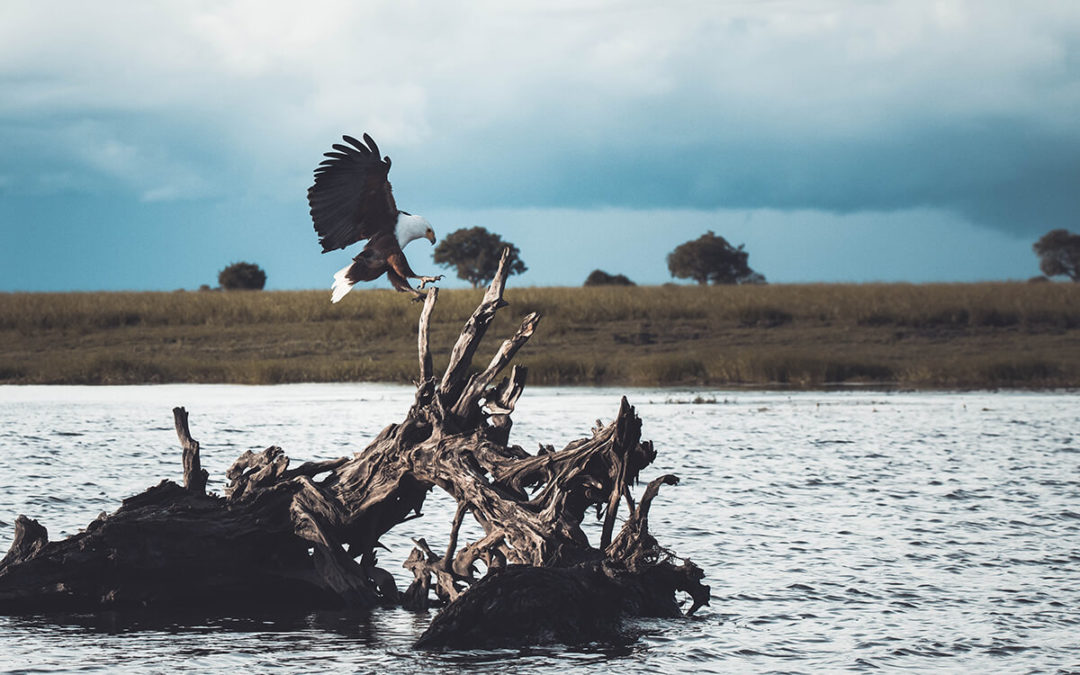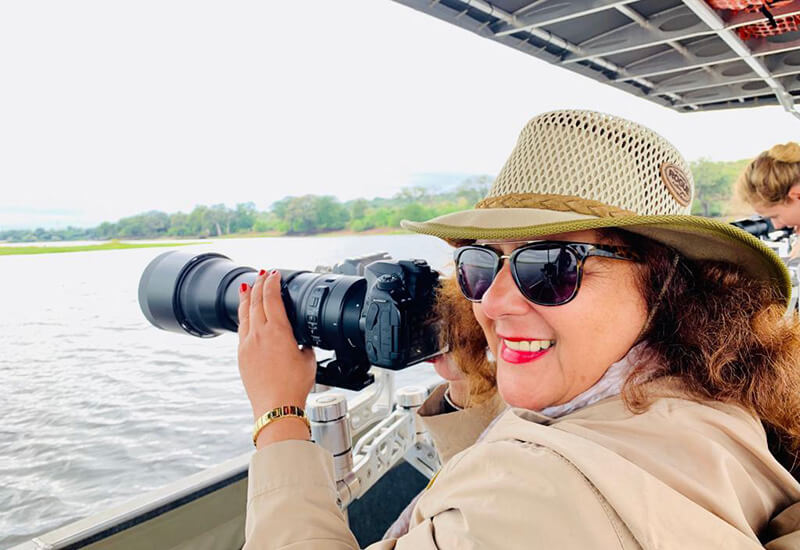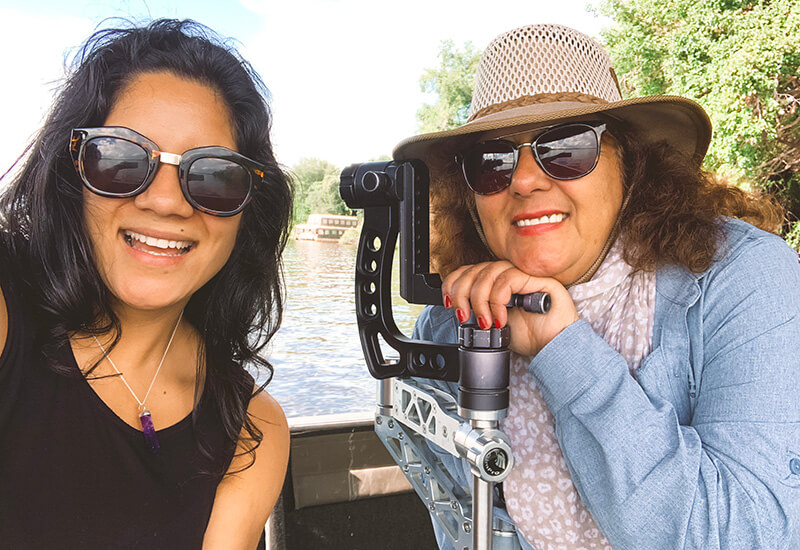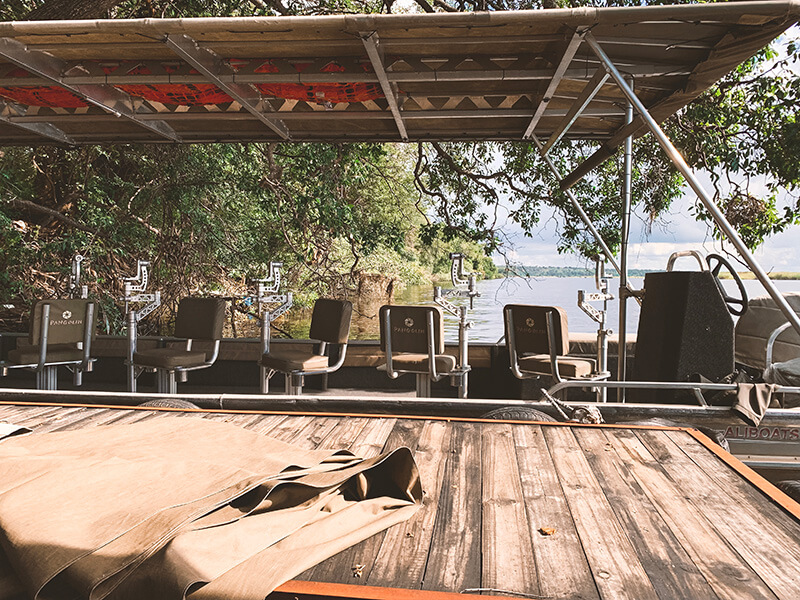Located in the northern end of Botswana, the Chobe National Park is the third-largest park in the country, and the most popular Botswana safari to experience. Aptly named after the Chobe River which is situated between Botswana and Namibia’s Caprivi strip, this region is incredibly lively while being home to a plethora of birds and animals year-round.
The Chobe landscape combines grasslands, mopane woodlands, thick scrub and floodplains into a mosaic of different geographical areas, providing shelter for the many Chobe National Park animals.
If you’re looking for a five-star tented camping Botswana trip or luxury safari experience, look no further than Chobe – it’s got everything you’d want for a memorable holiday in Southern Africa.
We’ve got all the details that you need to know about this magical Botswana safari!
Getting to Chobe National Park
The simplest way to get to Chobe National Park is to enter via a flight into Kasane Airport. This airport is right outside the town of Kasane and is very close to the northern entrance of Chobe National Park.
Some of the other airports you could fly in to include Victoria Falls Airport in Zimbabwe, as well as Harry Mwanga Nkumbula International Airport in Zambia. Both are about a two-hour drive from the northern entrance of the park. These options would work well if you are planning to visit other destinations first, but, if you intend to start your vacation with a Chobe safari, we suggest flying into Kasane.
Once you have arrived, the lodge will organise a private transfer from the airport to their premises.
When to visit the Chobe National Park
It’s well known that the best time to visit Botswana is during the dry season, which runs from May to October. You can expect sunny, warm and dry days, while the nights are cool.
Since there isn’t much water available in the park during this time, the animals congregate around the river. This makes it is easier to spot large varieties of animals together.
The wet season or rainy season is from November through to March, and sometimes stretching into late April. If you do choose to go on a Chobe safari during the wet, humid season, you can expect fewer tourists.
Malaria is especially prevalent during the late rainy season, from January to April. It’s strongly recommended to take anti-malarial prophylactics ahead of your trip if you’re travelling during this time.
What to pack for a Chobe safari
While you may be tempted to go on a massive shopping spree before your trip, you don’t need a whole new wardrobe to go on a Botswana safari!
The key to packing well for a Chobe safari is keeping it casual and staying comfortable.
We recommend packing light fabrics and loose-fitting clothing that is neutral in colour. Since it gets chilly in the early mornings and evenings, particularly during the winter months, you’ll need to bring a warm sweater or jacket and maybe even a scarf.
It’s also worth packing a pair of shorts and a pair or two of trousers. If your lodge has a swimming pool, remember to bring your bathing suit so that you can cool off during the hot afternoons!
You’ll also want to pack a hat and sunglasses with adequate UV protection, as well as a good sunscreen and mosquito repellant.
As far as your feet are concerned, bring light footwear that offers support and is comfortable enough to be walked in. Also, bring a few pairs of thin socks instead of bulky pairs. They’re generally more comfortable when out and about in the bush.
Wildlife to expect on a Chobe National Park safari
You might already know this, but Chobe National Park is a must-see area for birders, as it is home to over 450 recorded species. The Chobe National Park has one of the highest densities of raptors in Southern Africa, including species such as the bateleur eagle and the lappet-faced vulture, amongst others.
Some of the other birds you can expect to see are African skimmers gliding along the river, while the Chobe River banks are home to the incredible southern carmine bee-eater. Other notable species include the kori bustard (which is the largest flying bird in Africa), the white-backed night heron, the rosy-throated longclaw and even the long-toed lapwing.
Aside from birds, other wildlife in the area include huge volumes of elephants, which can consist of hundreds of animals in a single herd. It’s currently estimated that there are up to 120,000 elephants living within the Chobe National Park.
You can also expect to see a large number of buffalo and lions. While other wildlife to expect include antelope, leopard, cheetah, and the endangered African wild dog.
While it’s possible to see the big five at Chobe, rhinos are becoming increasingly difficult to find. On a brighter note, the Chobe River is a prime habitat for water-based animals, including hippos, Nile crocodiles and waterbuck.
Experiences at the Chobe National Park
Some of the incredible experiences waiting for you at the Chobe National Park include:
- The main highlight of any Chobe National Park safari is the game-viewing. Your safari trip will include a few game drives, including sunrise and sunset drives inside the park.
- Depending on your accommodation option, most lodges will offer a water safari or similar. Here you can venture out on the river to see the aquatic life. There are plenty of birds nesting and venturing at the water’s edge, and you’ll more than likely see a hungry hippo or a croc lazing on the river bank. One of the best things about a Chobe safari is the river cruise. The river is beautiful all day long, but the sunsets are just magnificent.
- If you want something a little different, consider a photographic wildlife safari in Botswana. Pangolin Photo Safaris offers guided photographic tours through both the Chobe National Park and on the Chobe River. You’ll get to explore both land and water with an experienced wildlife photographer who’ll help you capture the perfect shot. If you’re looking for a one-of-a-kind experience, look no further than this safari. You can choose between photographic tours on the river or mobile tented camps – or even both!
- Along with conventional safari game drives, you have the option of going on a night drive to see the incredible nocturnal animals in the park, including bushbabies, African wildcats and honey badgers.
- Some lodges offer walking safaris. If you love hitting that 10 000 step count and want to do it in the African savannah, ask your guides if they offer walking safaris in the bush.
There’s a lot of action and adventure to be had, depending on what you’re looking for! Explore the four different regions in the park, including the Chobe riverfront, the Ngwezumba pans, the Savute and the Linyanti. With so much area to cover, we’re sure you’ll be in for the jam-packed adventure of a lifetime.
Accommodation for your Botswana safari
From luxury tented camps to five-star safari lodges, you’re spoilt for choice with options for accommodation in Botswana.
Whether you’re after a high-end lodge or a more authentic tented camp experience, Botswana’s selection of accommodation options is truly incredible.
We recommend staying in more than one location to experience the contrasting landscapes and bountiful game life in the region as much as possible. As well as exploring the Chobe, we suggest tieing in a trip to the Okavango Delta too. Hopping between lodges is all part of the fun!
A Chobe National Park safari is one of the best Botswana safaris that you can experience. The region is brimming with wildlife and beautiful landscapes, as well as host to a few incredible experiences.
We love the Chobe region so much, especially for the incredible river sunsets. We suggest hopping from the Chobe to the Delta, and then into Zimbabwe to visit the amazing Victoria Falls. If you’d like us to plan a Botswana safari for you, get in touch!
If you have any questions about travelling to the Chobe National Park, we’d love to hear from you.






Friends of mine visited Chobe Game Lodge – l love them dearly – they brought me a tan baseball cap that had “ Chobe Game Lodge” on the front, and “BOTSWANA” on the back. It is very special to me. I have lost it and I am very sad. Can you put me in touch with the gift shop so I might purchase a replacement?
Thanks,
Benny Monteleone
Hi Benny,
Oh that’s really sad 🙁 Unfortunately, we aren’t stockists of this apparel but try and contact Chobe Game Lodge directly (https://www.chobegamelodge.com/) and see if you could be directed to the gift shop this way.